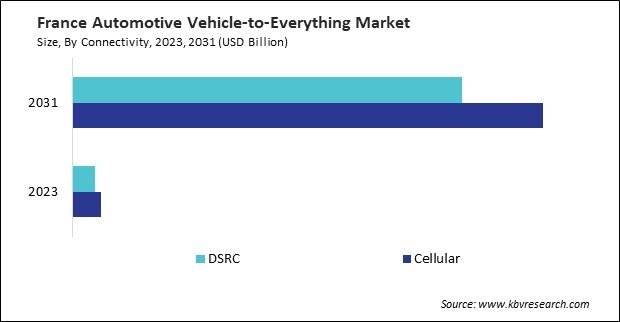The Europe Automotive Vehicle-to-Everything Market would witness market growth of 42.1% CAGR during the forecast period (2024-2031).
The Germany market dominated the Europe Automotive Vehicle-to-Everything Market by Country in 2023, and would continue to be a dominant market till 2031; thereby, achieving a market value of $1,882 million by 2031. The UK market is exhibiting a CAGR of 40.9% during (2024 - 2031). Additionally, The France market would experience a CAGR of 43.1% during (2024 - 2031).

Governments are actively promoting V2X as a solution to reduce road accidents and fatalities, with regulatory bodies introducing policies and mandates to accelerate its deployment. By leveraging AI-powered traffic control, predictive analytics, and automated vehicle coordination, V2X enables authorities to improve road safety and reduce urban congestion, making transportation networks more reliable and efficient. The rising demand for connected and autonomous vehicles is another major market driver. As automotive manufacturers invest in advanced driver assistance systems (ADAS) and autonomous driving technologies, V2X is becoming integral to modern vehicle ecosystems. As EV adoption continues to grow, V2X-enabled energy management systems are expected to be crucial in optimizing battery performance and reducing overall energy consumption in transportation networks.
The rapid advancements in CAVs drive the demand for V2X technology, enabling seamless communication between vehicles, infrastructure, pedestrians, and networks. As self-driving cars become more prevalent, real-time data exchange is crucial for safe navigation and collision avoidance. V2X facilitates this by allowing vehicles to share information about speed, road conditions, and obstacles, enhancing their ability to make split-second driving decisions. Automakers like Tesla, Waymo, and Mercedes-Benz already integrate V2X into their autonomous driving systems, improving vehicle coordination and responsiveness in complex urban environments. Without V2X, autonomous vehicles would face significant challenges in handling unpredictable traffic conditions and pedestrian movements, making this technology a fundamental pillar of modern mobility.
France plays a pivotal role in the European Union’s strategy for cross-border V2X communication, ensuring seamless vehicle-to-infrastructure (V2I) interaction across different regulatory environments. The French Ministry for the Ecological Transition has partnered with neighboring EU countries to develop cross-border connected vehicle corridors, allowing vehicles to maintain uninterrupted V2X communication while crossing national borders. These initiatives enhance road safety, reduce traffic congestion, and improve European mobility efficiency. As V2X adoption accelerates in Europe, the region presents significant growth opportunities for automakers, technology providers, and transportation authorities, ensuring a smarter, safer, and more connected future for European mobility.
Free Valuable Insights: The Global Automotive Vehicle-to-Everything Market will Hit USD 26.67 Billion by 2031, at a CAGR of 42.6%
Based on Device, the market is segmented into Onboard Unit and Roadside Unit. Based on Connectivity, the market is segmented into Cellular and DSRC. Based on Vehicle, the market is segmented into Passenger Cars and Commercial Vehicles. Based on Communication, the market is segmented into Vehicle-to-Vehicle (V2V), Vehicle-to-Infrastructure (V2I), Vehicle-to-Pedestrian (V2P), Vehicle-to-Network (V2N), Vehicle-to-Home (V2H), and Vehicle-to-Grid (V2G). Based on countries, the market is segmented into Germany, UK, France, Russia, Spain, Italy, and Rest of Europe.
By Device
By Connectivity
By Vehicle
By Communication
By Country
Our team of dedicated experts can provide you with attractive expansion opportunities for your business.

